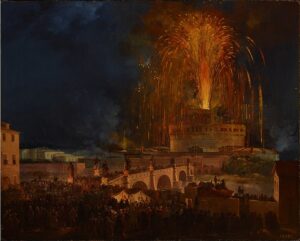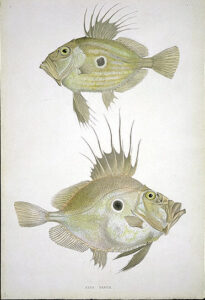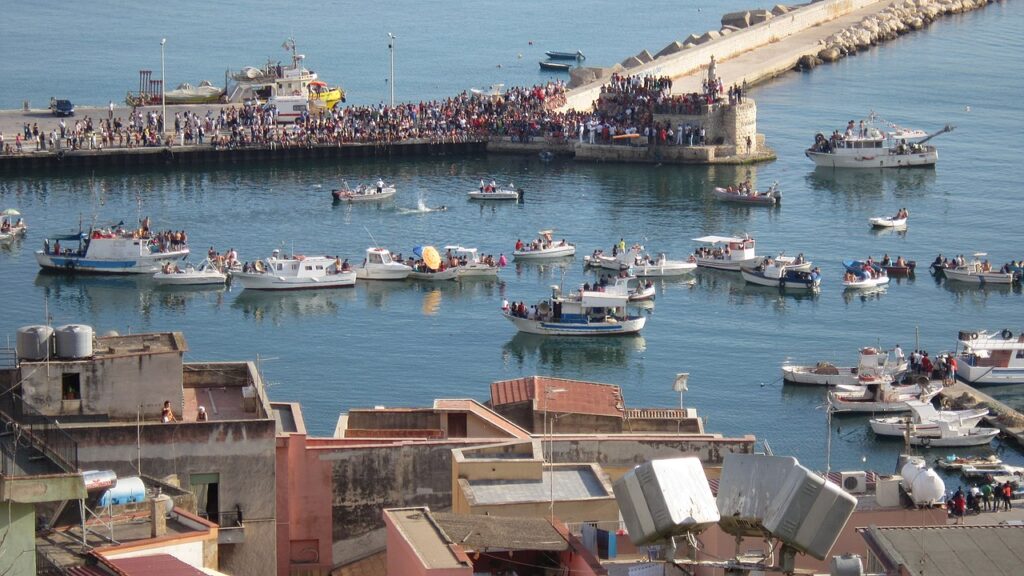Traditions of Ss. Peter and Paul
There are a vast number of ways for individuals and families to keep the feast of Ss. Peter and Paul, or “St. Peter’s Day”, as it has been colloquially known in English.
The first thing worth knowing for the modern Catholic is that, in most countries, it is still listed as a general Holy Day of Obligation, as we see in the current 1983 Code of Canon Law:
Can. 1246. §1. Sunday, on which by apostolic tradition the paschal mystery is celebrated, must be observed in the universal Church as the primordial holy day of obligation. The following days must also be observed: the Nativity of our Lord Jesus Christ, the Epiphany, the Ascension, the Body and Blood of Christ, Holy Mary the Mother of God, her Immaculate Conception, her Assumption, Saint Joseph, Saint Peter and Saint Paul the Apostles, and All Saints. §2. With the prior approval of the Apostolic See, however, the conference of bishops can suppress some of the holy days of obligation or transfer them to a Sunday.
As indicated in the last sentence, however, bishops’ conferences can modify this list with approval, and that is indeed why this holy day is no longer of obligation in the United States and Canada. Nonetheless, Holy Mass has always been an important part of the day’s tradition, and many of the customs mentioned below take place at the parish church or after Mass on that day.
Below I have collected some traditions surrounding the feast of Ss. Peter and Paul, drawn from the immemorial liturgy of the Roman Rite itself as well as the folk customs of Rome and the wider world of Latin Catholicism. (Naturally, as the day is such an important one throughout all of Christendom, the various Eastern Rites have their own venerable traditions.)
Fasting on the Vigil
As you will see in your daily Missals, June 28th is the vigil of Ss. Peter and Paul. Like other vigils, it is a penitential day liturgically: the vestments are violet, and the Gloria is suppressed. It used to be a required day of fasting as well, but not for over a century in Canada and the Commonwealth nations, and not since 1842 within the United States.
Although fasting on the vigil is not binding on Catholics any longer, the faithful may keep it voluntarily if they wish. The only caveat is that one does not keep any fast on years where the vigil falls on a Sunday. Traditionally, churches would either simply skip fasting that year altogether, or fast on the Saturday before the vigil: June 27th.
Customs of the Feast Day
In antiquity the Pope on this day led a pilgrimage accompanied by the Roman faithful and anchored by two pontifical Masses– one at the Vatican, and then one at St. Paul’s Outside the Walls. But the long distance between them proved burdensome, so eventually St. Paul was given his own feast on June 30th.
 La Girandola–“the Pinwheel”–is an elaborate fireworks show at Castel Saint’Angelo to the east of the Vatican, along the Tiber River. Tradition ascribes the show to the artist Michelangelo, although the celebration of saints’ days with fireworks seems to have been rather common in his day. Though suspended in 1886, it has been revived in recent years. Another old custom within the Vatican is to dress the statue of St. Peter in solemn papal vestments on the evening of the vigil, June 28th.
La Girandola–“the Pinwheel”–is an elaborate fireworks show at Castel Saint’Angelo to the east of the Vatican, along the Tiber River. Tradition ascribes the show to the artist Michelangelo, although the celebration of saints’ days with fireworks seems to have been rather common in his day. Though suspended in 1886, it has been revived in recent years. Another old custom within the Vatican is to dress the statue of St. Peter in solemn papal vestments on the evening of the vigil, June 28th.
Another Roman custom is the Infiorata–“flowering”—which was born on the 29th of June in 1625, when the head florist of the Vatican Benedetto Drei decorated St. Peter’s basilica with beautiful mosaic flower carpets. Though the custom was shortly after abandoned for almost four centuries, nearby places like the Alban Hills kept the tradition alive until it was finally restored to Rome in 2011. The artwork for the infiorata is elaborately planned and conceived, but for the feast families can easily do scaled-down versions at home. The general rule is to use the most natural materials possible–not only various colored flowers but also herbs, soil, coffee grounds, beans, etc. Begin by sketching out a drawing in chalk on the floor, then sprinkling coffee grounds or soil over the chalk to create the outlines of the drawing. Then fill each section with flowers or other materials as appropriate. Then, during a procession or at the close of festivities, the children are encouraged to walk or run across the images and erase them.
Nautical celebrations are very popular on this day. In many coastal communities around the world, from South America all the way to Gloucester, Massachusetts, June 29th is a day not only for carnivals, parades, and processions but also boat decoration and boat races. In Nice, on the French Riviera, the guild of fishermen has a custom to burn the boat of the poorest one among them, and replace it with a new one.
Landlocked regions may not be as able to keep maritime traditions, but they nevertheless have their own customs. In Hungary the feast day marks the beginning of the wheat harvest–with just a symbolic sweep of the scythe to respect the holiday from servile work. Hungarians bring grain, bread, and woven straw decorations to their churches to be blessed, and harvest wreaths were made and displayed until Christmas. In Alpine countries there was a tradition to kneel beneath a garden tree and recite the Angelus at the ringing of the Angelus bell, in order to receive the Papal blessing carried by angels throughout the world. Austria and Bavaria have a tradition of the Petersfeuer bonfire, perhaps an extension of the fires that traditionally accompanied the feast of St. John the Baptist on June 23rd.
The Foods of the Feast
Because St. Peter was originally a fisherman, seafood was prominent in the day’s cuisine.

There are a few species that were given the popular name of “St. Peter’s fish”. One is the John Dory (Zeus faber) of the Mediterranean Sea and the oceans of the Eastern Hemisphere; its unattractive appearance belies its excellent taste (see this recipe from Buon Appetito, Your Holiness: The Secrets of the Papal Table). It has a prominent round dark spot on its flank like a coin; so legend attached it to Christ’s miracle of the coin in the fish’s mouth, from Matthew 17:27.
Several other species in the Holy Land are called “St. Peter’s fish.” These are the Mango tilapia or Galilean St. Peter’s fish (Sarotherodon galilaeus), the common St. Peter’s fish (Tilapia zilli), and the Jordan St. Peter’s fish (Oreochromis aureus). The Galilean species was legendarily the fish multiplied in the Miracle of Loaves and Fishes; and these local Galilean recipes will enable you to treat the family to a taste of Peter’s home region.
Finally, when in 1868 the Trappists took over the Tre Fontane Abbey at the site of St. Paul’s martyrdom, they brought with them a recipe for chocolate that quickly earned them fame in the city. Since then, Romans have made it a habit of visiting them early on the morning of the feast and enjoying rosette rolls and hot chocolate amid the quiet peacefulness of the abbey’s eucalyptus trees. That’s right–having chocolate on the feast of Ss. Peter and Paul is a very Roman way to celebrate this very Roman feast!
Celebrating the Octave

The most important Catholic feast days were traditionally not over and done with in one day, but extended over a whole week of celebration. Ss. Peter and Paul enjoyed a common octave all the way up to 1955, when it was suppressed by Pius XII. The octave is therefore missing from missals printed after that day, although if you happen to have a pre-1955 Missal such as Lasance’s New Roman Missal, you will still find it listed.
Nothing prevents the faithful from still keeping the octave privately as a pious devotion. The simplest way to do that is to pray the collects of the Masses. On June 29th the prayer is as follows:
O God, who hast consecrated this day to the martyrdom of Thine apostles Peter and Paul, grant to Thy Church in all things to follow their teaching by whom it received the right ordering of religion in the beginning.
The next day, June 30th, is the feast of St. Paul, and both the pre-1955 and 1962 Missals have special collects:
O God, Who didst teach the multitude of the nations by the preaching of the blessed Apostle, Paul, grant us, we beseech Thee, that, venerating his natal day, we may experience the benefits of his intercession with Thee.
O God, Who, in conferring upon blessed Peter, Thine apostle, the keys of the heavenly kingdom, didst commit to him the priestly power of binding and loosing, grant that, by the help of his intercession, we may be delivered from the bonds of our sin.
On each day of the octave from July 1st to July 5th, the collect of the feast is said:
O God, who hast consecrated this day to the martyrdom of Thine apostles Peter and Paul, grant to Thy Church in all things to follow their teaching by whom it received the right ordering of religion in the beginning.
Finally, there is a unique collect for July 6th, the octave-day:
O God, whose right hand raised up blessed Peter, when he walked upon the waves, that he might not sink, and delivered his fellow-apostle Paul, thrice shipwrecked, from the depths of the sea, graciously hear us, and grant that, by the merits of them both, we may reach the glory of eternity.
Alternatively, the following commemoration can be made on each day of the octave from June 29th to July 6th:
Commemoration of Ss. Peter and Paul
Antiphon. Peter, the Apostle, and Paul, the Doctor of the nations, these have taught us Thy law, O Lord.
Verse. Thou shalt make them princes over all the earth.
Response. They shall remember Thy name, O Lord.
Let us pray.
O God, Who hast made holy this day by the martyrdom of Thine apostles, Peter and Paul, grant unto Thy Church that as through them she first received the faith, so may she in all things follow their precepts. Through Christ our Lord, Amen.
Celebrating Beyond the Octave
In a previous article I noted that, in Carolingian times, the long Post-Pentecost season was divided into various subseasons, and in this scheme, the feast of Ss. Peter and Paul was so important that it marked a transition from one subseason to another.
From the Pentecost octave to June 29th were the “Sundays of Pentecost” proper. After the feast was the Sunday post Natalem Apostolorum–“after the Birthday of the Apostles”. This last Sunday was followed by a sequence of six or seven numbered “Sundays after the Octave of the Apostles”, that filled up the time to the feast of St. Lawrence on August 10th.
This was a characteristically Roman arrangement. The Ambrosian rite of Milan did things quite differently, instead transitioning from the “Sundays after Pentecost” to the “Sundays after the Decollation” after the feast of St. John the Baptist on August 29th.
So, at least historically, the Roman liturgical books had a named liturgical subseason dedicated to Saints Peter and Paul that ran from the feast on June 29th to the vigil of St. Lawrence on August 9th. The name has since disappeared, so you won’t necessarily find it in your missals. But the evidence of it can still be seen in the Sunday Mass readings.
All of the Epistles of the 3rd to the 8th Sundays after Pentecost–which is roughly about the timeframe within which June 29th can fall–come from either the First Epistle of Peter or Paul’s Epistle to the Romans. And the readings for the 4th Sunday are Paul’s Epistle to the Romans prefiguring his martyrdom and the Gospel of Luke with St. Peter’s miraculous draught of fishes. This Petrine Gospel seems to be a clear case of the Sanctoral calendar making its mark on the Sunday calendar; as Fr. Francis X. Weiser points out, this also occurred with other highly venerated Roman martyrs like St. Lawrence and Ss. Cosmas and Damian.
As a way of restoring this “Petrine” subseason, families may wish to decorate their homes with extra images of the Apostles and their symbols (e.g. keys and swords). Having the children make and display scale model churches–particularly St. Peter’s in Rome–out of building toys fits the spirit of the season quite well. An important theme of the Post-Pentecost season is the growth and progress of the Church throughout the ages. So once we have already celebrated Peter and Paul’s martyrdom and founding of the Church over the octave, it is good to spend a little while meditating on how their Apostolic work helped build the institution of the Papacy, bring the Gospel to all the Gentile nations, and benefit the entire Church.
June 27, 2023









